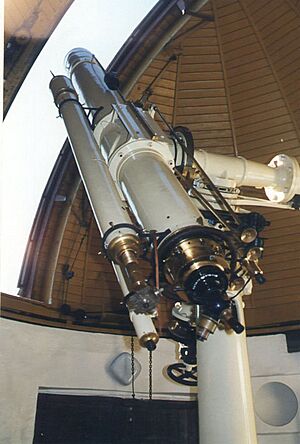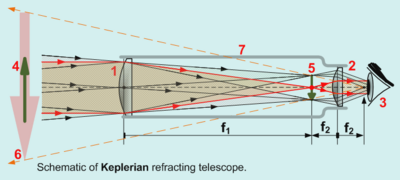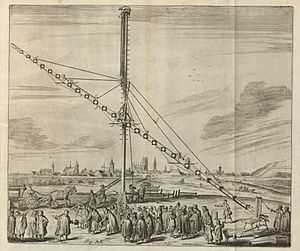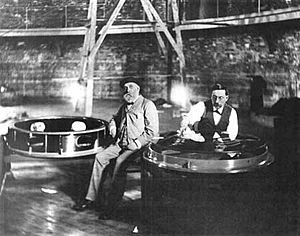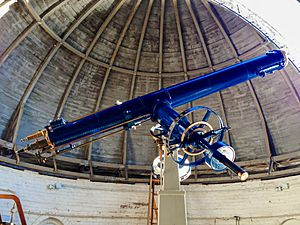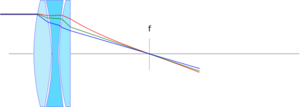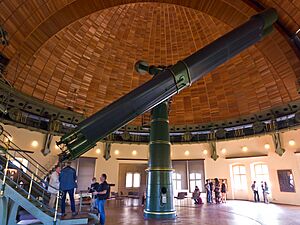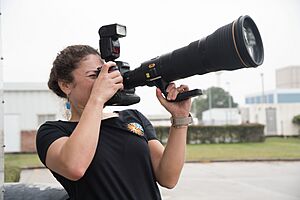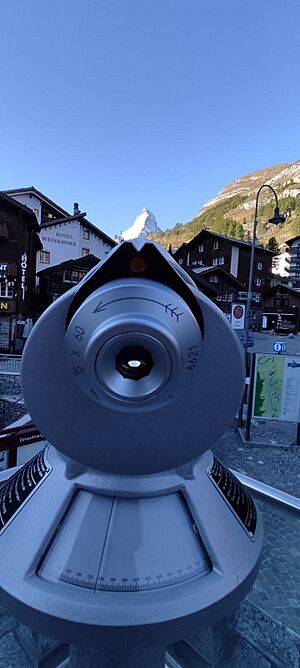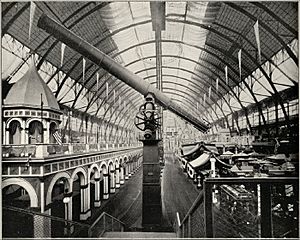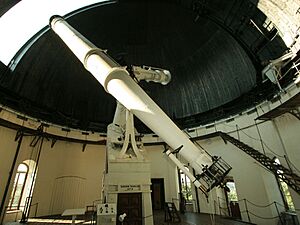Refracting telescope facts for kids
A refracting telescope is a type of optical telescope. It uses a lens at the front to gather light and form an image. This is why it's also called a refractor.
Refracting telescopes were first used in spyglasses and for looking at stars. They are also used in long camera lenses. In the past, large refractors were very popular. But now, reflecting telescopes are often used for research. Reflectors can have much bigger lenses.
To find out how much a refractor magnifies, you divide the focal length of its main lens by the focal length of its eyepiece.
Most refracting telescopes have a lens at the front. Then there's a long tube, and an eyepiece or other tools at the back. This is where you see the focused view. Early telescopes had one lens. Later, lenses with two or even three parts were made.
The technology from refracting telescopes is also used in other tools. These include binoculars and zoom lenses.
Contents
Invention of the Telescope
Refractors were the very first type of optical telescope. The first record of a refracting telescope came from the Netherlands around 1608. A spectacle maker named Hans Lippershey tried to get a patent for one.
News of this invention spread quickly. Galileo Galilei heard about it in May 1609 while in Venice. He built his own version and used it to make amazing discoveries about space.
How Refracting Telescopes Work
All refracting telescopes work in a similar way. They use an objective lens (1) and an eyepiece (2). This combination helps them gather more light than your eye can. They focus this light (5) to create a brighter, clearer, and magnified image (6).
The objective lens in a refractor bends or refracts light. This bending makes parallel light rays meet at a focal point. Light rays that are not parallel meet at a focal plane. The telescope changes how light rays travel. This makes objects look bigger.
Refracting telescopes can be designed in different ways. These designs help fix problems with how the image looks. Because they bend light, they are called refracting telescopes or refractors.
Galilean Telescope
The design Galileo Galilei used around 1609 is called a Galilean telescope. It had a lens that brought light together (objective lens). It also had a lens that spread light out (eyepiece lens). A Galilean telescope creates an image that is not upside down.
Galileo's strongest telescope was about 980 millimeters (3.2 feet) long. It made objects look about 30 times bigger. Galileo had to use the simple lens technology of his time. He found he needed to cover part of the main lens to reduce blurry images. This made his telescope produce blurry and distorted views with a narrow field of vision.
Even with these problems, Galileo's telescope was good enough to explore the sky. He used it to see craters on the Moon. He also saw the four largest moons of Jupiter, called the Galilean moons. He even observed the phases of Venus.
Light rays from a distant object (y) would be focused by the objective lens (L1). The eyepiece lens (L2) then catches these rays and makes them parallel again. This makes the object appear larger.
The final image (y″) is a virtual image. It appears far away and is the same way up as the actual object.
Keplerian Telescope
The Keplerian telescope was invented by Johannes Kepler in 1611. It was an improvement on Galileo's design. It used a convex lens for the eyepiece instead of Galileo's concave one.
This design had a wider view and was easier to look through. However, the image you saw was upside down. This design could achieve much higher magnifications. But like Galileo's telescope, it used simple lenses. This meant it needed to be very long to reduce image problems. For example, Johannes Hevelius built a huge f/225 telescope. It had an 8-inch lens and was 150 feet long! Even longer "aerial telescopes" were built without tubes.
This design also allowed for a micrometer to be used. This tool could measure the size or distance between objects seen through the telescope.
Achromatic Refractors
The next big step for refracting telescopes was the achromatic lens. This lens has multiple parts. It helped fix problems with color distortion and allowed for shorter telescopes.
It was invented in 1733 by Chester Moore Hall. John Dollond also invented and patented it around 1758. This new design solved the need for very long telescopes. It used two pieces of glass with different properties. These were 'crown' and 'flint glass'. They worked together to reduce color and shape distortion. Each side of each piece is shaped and polished. Then the two pieces are joined. Achromatic lenses are made to focus two colors (usually red and blue) at the same spot.
Dollond's achromatic telescopes were very popular in the 1700s. A big reason was that they could be made shorter. But making large glass lenses was hard. So, the lenses were usually no more than about four inches wide.
In the late 1800s, Pierre-Louis Guinand found a way to make larger, better quality glass. He shared this with his student Joseph von Fraunhofer. Fraunhofer improved the method and designed the Fraunhofer doublet lens. This breakthrough led to the huge refractors of the 19th century. They grew bigger and bigger, reaching over 1 meter (39 inches) by the end of the century. After this, reflecting telescopes with silvered mirrors took over in astronomy.
Some famous lens makers of the 19th century include:
- Alvan Clark
- Fraunhofer
- Grubb
- Henry Brothers
Some famous 19th-century doublet refractors are the James Lick telescope (91 cm/36 in) and the Greenwich 28 inch refractor (71 cm/28 in). The "Trophy Telescope" at the 1851 Great Exhibition in London was also famous. The era of the 'great refractors' in the 19th century saw very large achromatic lenses. The largest ever built was the Great Paris Exhibition Telescope of 1900.
At the Royal Observatory, Greenwich, an 1838 telescope called the Sheepshanks equatorial has a lens by Cauchoix. This lens was 6.7 inches (17 cm) wide. It was the biggest telescope at Greenwich for about 20 years.
In the 1900s, Zeiss was a well-known optics maker. The 12-inch Zeiss refractor at Griffith Observatory has been used by over 7 million people since 1935. This is more people than any other telescope.
Achromatic telescopes were good for making star catalogs. They also needed less care than metal mirrors. Important discoveries made with achromats include the planet Neptune and the Moons of Mars.
Long achromatic telescopes were often chosen for "prestige" observatories. This was even though reflectors could be larger. In the late 1700s, a new, larger refractor would appear every few years. For example, the Nice Observatory opened with a 77 cm (30 inch) refractor. It was the largest at the time, but it was soon surpassed.
Apochromatic Refractors
Apochromatic refractors use special materials that spread light very little. They are designed to focus three colors (like red, green, and blue) at the same point. This makes the image much clearer with almost no color problems.
These telescopes use parts made of fluorite or special "extra-low dispersion" (ED) glass. This makes the image very sharp and free of color distortion. Because of the special materials, apochromatic refractors are usually more expensive than other telescopes of the same size.
In the 1700s, Dollond, a popular maker of two-part lenses, also made three-part lenses. However, these were not as popular as the two-part ones.
One famous three-part lens is the Cooke triplet. It is known for fixing many image problems. It is considered one of the most important objective designs in photography. The Cooke triplet can fix problems like spherical aberration, coma, and astigmatism with only three parts.
Things to Consider About Refractors
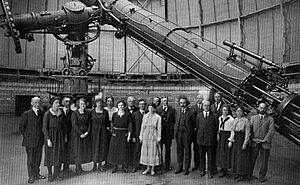
Refractors have some problems with leftover color and shape distortion. These problems are worse for telescopes with shorter focal ratios. An f/6 achromatic refractor might show a lot of color fringing (a purple glow around bright objects). An f/16 achromat has much less color fringing.
For very large lenses, there's also the problem of the lens sagging. This happens because gravity pulls on the glass. Since a large lens can only be held by its edges, the center sags. This distorts the images. The biggest practical lens size for a refracting telescope is about 1 meter (39 inches).
Another problem is tiny flaws in the glass, like streaks or small air bubbles. Also, glass can block certain wavelengths of light. Even visible light gets dimmer as it passes through the glass and reflects off its surfaces. Most of these problems are avoided in reflecting telescopes. Reflectors can be made much larger. They have mostly replaced refractors for astronomy research.
The ISS-WAC camera on the Voyager 1 and 2 spacecraft used a 6 cm (2.4 inch) lens. These were launched into space in the late 1970s. This shows how refractors are still used in space.
What Refractors Have Achieved
Refracting telescopes were important for looking at stars and for viewing things on Earth. Many early discoveries about our Solar System were made with simple refractors.
Refracting optics are also used everywhere in photography. They are even used in Earth orbit.
One of the most famous uses of the refracting telescope was when Galileo used it. In 1609, he discovered the four largest moons of Jupiter. Later, early refractors were also used to find Titan, the largest moon of Saturn, and three more of Saturn's moons.
In the 1800s, refracting telescopes were used for early work in astrophotography (taking pictures of space) and spectroscopy (studying light). A related tool, the heliometer, was used to measure the distance to another star for the first time.
Even though they were smaller than reflectors, refractors made some important discoveries. These include the Moons of Mars, a fifth moon of Jupiter, and many double stars like Sirius. Refractors were often used to find the exact positions of stars.
- Single-Lens Telescopes
The Galilean moons and many other moons in our solar system were found with telescopes that had only one main lens.
Galileo Galilei discovered Jupiter's Galilean satellites in 1610 using a refracting telescope.
Saturn's moon, Titan, was discovered on March 25, 1655, by the Dutch astronomer Christiaan Huygens.
- Double-Lens Telescopes
In 1861, the brightest star in the night sky, Sirius, was found to have a smaller companion star. This was done using the 18.5-inch Dearborn refracting telescope.
By the 1700s, reflectors started to compete with refractors. Reflectors could be made very large and didn't have the same color problems. Still, astronomers kept using double-lens refractors. Important discoveries include the Moons of Mars and a fifth moon of Jupiter, Amalthea.
Asaph Hall discovered Deimos on August 12, 1877, and Phobos on August 18, 1877. He used the 26-inch refractor at the US Naval Observatory in Washington, D.C.. In 1893, this lens was moved to a new dome, where it still is today.
Jupiter's moon Amalthea was discovered on September 9, 1892, by Edward Emerson Barnard. He used the 36-inch refractor telescope at Lick Observatory. He saw it directly through the telescope.
In 1904, the Great Refractor of Potsdam (a double telescope) helped discover the interstellar medium. Professor Hartmann found the element calcium in the space between stars. He did this by observing the binary star Mintaka.
- Triple-Lens Telescopes
The planet Pluto was discovered by looking at photographs taken with a refracting telescope. This telescope was an astrograph with a 3-part, 13-inch lens.
Largest Refracting Telescopes
Here are some of the largest achromatic refracting telescopes, all over 60 cm (24 inches) in diameter:
- Great Paris Exhibition Telescope of 1900 (1.25 m or 49 in) – taken apart after the exhibition
- Yerkes Observatory (102 cm or 40 in)
- Swedish 1-m Solar Telescope (98 cm or 39 in)
- Lick Observatory (91 cm or 36 in)
- Paris Observatory Meudon Great Refractor (83 cm or 33 in, plus 62 cm or 24 in)
- Potsdam Great Refractor (80 cm or 31 in, plus 50 cm or 20 in)
- Nice Observatory (77 cm or 30 in)
- John Wall (76 cm or 30 in) dialyte refracting telescope – the largest refractor built by an individual
- 28-inch Grubb Refractor at Royal Greenwich Observatory (71 cm or 28 in)
- Great Refractor of Vienna Observatory (69 cm or 27 in)
- Archenhold Observatory – the longest refracting telescope ever built (68 cm or 27 in lens with a 21 m or 69 ft focal length)
- United States Naval Observatory refractor (66 cm or 26 in)
- Newall refractor at the National Observatory of Athens (62.5 cm or 24.6 in)
- Lowell Observatory (61 cm or 24 in)
See also
 In Spanish: Telescopio refractor para niños
In Spanish: Telescopio refractor para niños
- Astrograph
- Baden-Powell's unilens
- Catadioptric telescopes
- List of largest optical refracting telescopes
- List of largest optical telescopes historically
- List of telescope types
- Reflecting telescope
- Star diagonal
- Heliometer


